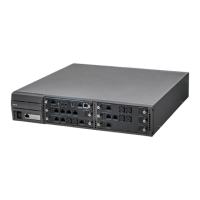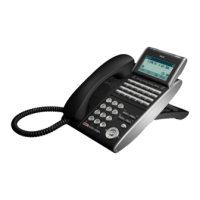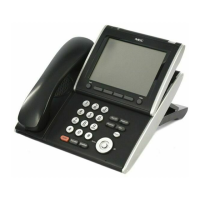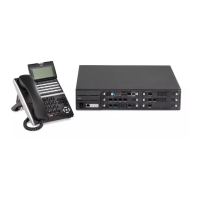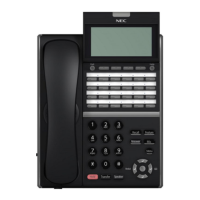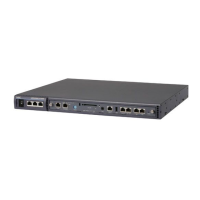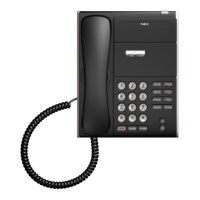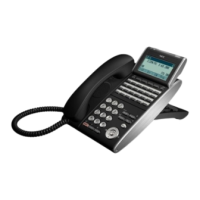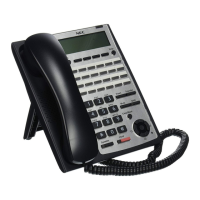Why is there noise during my NEC SV9100 call?
- AAustin TurnerJul 26, 2025
The voice quality of NEC IP Phones can be affected by network conditions, which can cause noise during a call.












Why is there noise during my NEC SV9100 call?
The voice quality of NEC IP Phones can be affected by network conditions, which can cause noise during a call.
What to do if the pickup icon is not working on my NEC Telephone?
If the pickup icon is not working on your NEC Telephone and your number is registered in the same pickup group, contact either your network administrator or your service provider.
How to fix white lines on the screen of my NEC SV9100 Telephone?
If white lines appear on the screen of your NEC Telephone, leave the power on for a while, and the lines will disappear.
Defines a list of buddies showing online/offline status, BLF, IM, presence, and status messages.
Allows making/receiving internal/external calls, answering, holding, transferring, and conferencing.
Shows call history of the controlled desktop phone and allows calling from the list.
Displays status of programmed function keys on the desktop phone.
Enables sending emails to InUC users via the default mail client.
Allows sending instant messages to one or more InUC users with timestamps.
Enables setting/canceling Call Forwarding and Do Not Disturb, links to Web Programming.
Details recommended PC and mobile specifications and browser compatibility.
Lists terminals supported for InUC Desktop Phone mode.
Lists licenses required for InUC features like Web Client, CTI, and Video Conferencing.
Steps to enter ID and Password on the login screen.
How to set presence status (e.g., In Office, Out to Lunch) via the drop-down menu.
Users can enter a status message visible on their buddy list entry.
Defines buddies, shows their status, and how to view/edit the contact list.
How to sort the contact list by division.
Steps to create or edit the Buddy List.
How to add buddies by highlighting the star icon.
Describes the confirmation screen for changing buddy status.
How to view buddy details by clicking the presence icon or name.
How to turn the alphabetical index on or off on the home page.
How to sort the home page by Division or Presence status.
How to access the Speed Dial list from the menu.
Steps to place a call using the Speed Dial list.
How to access the Web Conference feature from the menu.
Steps to invite up to seven parties to a Web Video Conference.
Describes the Instant Message invitation containing a hyperlink to the conference.
How to mute/unmute audio and start/stop video streams.
How to share an application or the entire screen.
How to adjust the video resolution from a dropdown menu.
Steps to send an instant message to a group of users.
Displays an example of an incoming instant message notification.
Users can archive instant messages into a text file.
Steps to send an email to a group of users via Multicast Mail.
Displays the version information of the InUC Web Client.
A warning is displayed about losing unsaved IM history upon exit.
Ways to make an outgoing call, including using the Dial Pad.
How to answer an incoming call using the green Answer button.
How to view indications of ringing calls while on an active call.
How to place an active call on hold using the Hold button.
How to initiate a blind transfer of a call.
Steps to perform a supervised transfer of an active call.
How to press the Conference icon with an active call.
How to add more parties to an established conference call.
How to end an active call by clicking the red Hangup icon.
How to send DTMF tones to a connected party using the dial pad.
Displays incoming and outgoing calls with details like time and number.
Sections for setting and canceling call forwarding types and destinations.
Displays programmed function keys and their status.
Lists supported languages and conditions for their use.
Defines a list of buddies showing online/offline status, BLF, IM, presence, and status messages.
Allows making/receiving internal/external calls, answering, holding, transferring, and conferencing.
Shows call history of the controlled desktop phone and allows calling from the list.
Displays status of programmed function keys on the desktop phone.
Enables sending emails to InUC users via the default mail client.
Allows sending instant messages to one or more InUC users with timestamps.
Enables setting/canceling Call Forwarding and Do Not Disturb, links to Web Programming.
Details recommended PC and mobile specifications and browser compatibility.
Lists terminals supported for InUC Desktop Phone mode.
Lists licenses required for InUC features like Web Client, CTI, and Video Conferencing.
Steps to enter ID and Password on the login screen.
How to set presence status (e.g., In Office, Out to Lunch) via the drop-down menu.
Users can enter a status message visible on their buddy list entry.
Defines buddies, shows their status, and how to view/edit the contact list.
How to sort the contact list by division.
Steps to create or edit the Buddy List.
How to add buddies by highlighting the star icon.
Describes the confirmation screen for changing buddy status.
How to view buddy details by clicking the presence icon or name.
How to turn the alphabetical index on or off on the home page.
How to sort the home page by Division or Presence status.
How to access the Speed Dial list from the menu.
Steps to place a call using the Speed Dial list.
How to access the Web Conference feature from the menu.
Steps to invite up to seven parties to a Web Video Conference.
Describes the Instant Message invitation containing a hyperlink to the conference.
How to mute/unmute audio and start/stop video streams.
How to share an application or the entire screen.
How to adjust the video resolution from a dropdown menu.
Steps to send an instant message to a group of users.
Displays an example of an incoming instant message notification.
Users can archive instant messages into a text file.
Steps to send an email to a group of users via Multicast Mail.
Displays the version information of the InUC Web Client.
A warning is displayed about losing unsaved IM history upon exit.
Ways to make an outgoing call, including using the Dial Pad.
How to answer an incoming call using the green Answer button.
How to view indications of ringing calls while on an active call.
How to place an active call on hold using the Hold button.
How to initiate a blind transfer of a call.
Steps to perform a supervised transfer of an active call.
How to press the Conference icon with an active call.
How to add more parties to an established conference call.
How to end an active call by clicking the red Hangup icon.
How to send DTMF tones to a connected party using the dial pad.
Displays incoming and outgoing calls with details like time and number.
Sections for setting and canceling call forwarding types and destinations.
Displays programmed function keys and their status.
Lists supported languages and conditions for their use.
| Unified Messaging | Yes |
|---|---|
| VoIP Support | Yes |
| SIP Support | Yes |
| VoIP Protocols | SIP, H.323 |
| Mobility | Yes |
| Type | IP-PBX |
| Power Supply | AC 100-240V, 50/60Hz |
| Operating Temperature | 0°C to 40°C (32°F to 104°F) |
| Humidity | 10% to 90% (non-condensing) |
| System Type | Hybrid (Supports Analog, Digital, and IP) |
